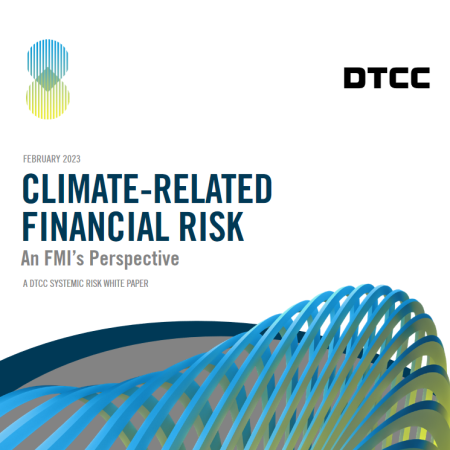
DTCC issues first-ever analysis on how climate-related financial risk may impact financial market infrastructures
New whitepaper highlights the unique nature of FMIs’ exposure to climate-related risk and emphasizes value of existing regulatory framework
The Depository Trust & Clearing Corporation (DTCC), the premier post-trade market infrastructure for the global financial services industry, today issued the first-ever analysis that examines how climate-related financial risk, namely physical risk and transition risk, may impact financial market infrastructures (FMIs).
The new whitepaper, “Climate-Related Financial Risk: An FMI’s Perspective,” acknowledges that FMIs can have direct exposure to climate-related physical risk. While FMIs’ existing business continuity programs have proven to be sufficiently robust to withstand the impact of extreme weather events, these programs should continue to be enhanced to prepare for potentially more frequent and more damaging climate-related events in the future. The paper also indicates that, while financial institutions face direct exposure to physical risk and indirect exposure to transition risk through their financing activities, FMIs’ exposure to these risks via financial institutions is even more ancillary. Additionally, given the specific nature of its activities, the duration of an FMI’s exposure to risk is considerably shorter than the risk horizon of other financial services entities.
In response to FMIs’ unique risk exposure, the paper recommends that existing regulatory frameworks and standards be applied to FMIs to effectively mitigate future climate-related financial risk challenges. More specifically, the Principles for Financial Market Infrastructures (PFMIs) that were created by CPMI-IOSCO contain effective and adaptative guidance that could be applied for this purpose.
“Climate change is no longer being considered exclusively an environmental issue, but a multifaceted source of economic and financial risks that could threaten the stability of the financial ecosystem. As such, DTCC includes climate-related financial risk as one of the many potential systemic threats that it actively analyzes and monitors,” stated Michael Leibrock, Chief Systemic Risk Officer at DTCC. “This paper presents an innovative analysis that examines how climate-related risk can impact FMIs via direct and indirect risk transmission channels. The overarching message is that existing PFMI guidance were appropriately designed by global policymakers to cover FMIs’ unique exposure to climate-related financial risk.”
The paper also highlights that, while green bonds can play a significant role in contributing to the funding required to address the global challenges of climate change, these instruments should not be given preferential treatment around how they are risk managed, including in the collateral management process.
Leibrock added, “To do so, in our opinion, would be to prioritize environmental considerations above the core mandate of FMIs of ensuring a resilient post-trade infrastructure for the securities industry.”
As part of DTCC’s approach to mitigating its exposure to climate-related risk, DTCC’s Business Continuity team is adding climate-related trending metrics to its existing programs to improve the company’s risk management capabilities. In addition, DTCC’s Counterparty Credit Risk team is looking to incorporate climate-related risk monitoring as part of its overall approach to assessing counterparty exposure, compliance, controls, and governance.
Stated Adrien Vanderlinden, DTCC Systemic Risk Executive, “In addition to our efforts to continue to evolve how we monitor and mitigate financial and transition risk attributed to climate change, DTCC is committed to doing our part to contribute to a greener economy. In support of this, we have embarked on a multi-year program to reduce our carbon footprint operationally, through our suppliers, and as financiers of renewable energy.”


